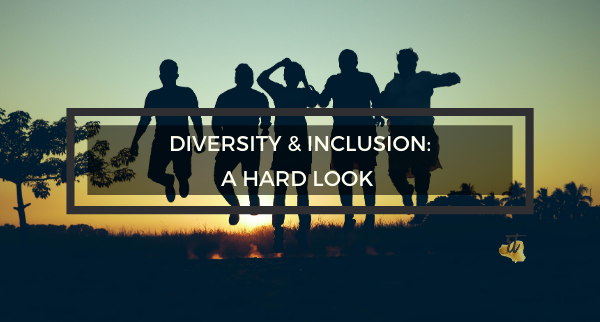D&I: A Hard Look
I am super happy to see companies adopting Diversity and Inclusion within their workplace. It’s definitely something that’s been the highlight of 2020 through different events such as #blacklivesmatter. But, one question that seems to keep pestering me is, do companies really understand Diversity and Inclusion?
The more I search for evidence that companies do understand the core of D&I, the more I’m disheartened to see that may not be the case. Now, I’ll warn you before you read any further, I am an opinionated individual. That’s what led me into the impact management game, however, it all started from the core principles of equity and fairness. I understand the core of equity of fairness whilst knowing I still have much to learn. Therefore, today’s article has been created to help corporate leaders readjust their attempts at D&I through more education and an eye-opening perspective that might have you question your own biases within the world of Diversity and Inclusion.
Like I said above, 2020 has really accelerated the idea of Diversity and Inclusion through social demand. Movements like BLM magnified by circumstances of major focus because of COVID-19 have really helped us highlight the problems of true representation of D&I within a company. Because of movements, particularly BLM, I’m seeing companies really play hard to hire more black people within their organization. And not just hire black people within the organization but to hire black people in positions of authority. I LOVE it! I think it’s not only phenomenal but long overdue. However, I am seeing a bias trend. I call it hyperfocus.
You see, in my opinion, companies are now hyperfocused on hiring black people so to tick off the D&I needs of societal demands today. With that hyperfocus, however, comes a new form of exclusion for tomorrow, period.
Because companies are so focused on hiring POCs right now, they’re seemingly losing sight of the core principles of D&I.
Diversity and Inclusion, in essence, means representing all forms and norms. Not excluding based on, you fill in the blank. So, how does being hyperfocused on implementing D&I within the organization create bias?
Well, in 2020, it’s POCs, which means automatically companies are not practicing diversity and inclusion. They’re fulfilling a need to represent POCs within the company and to ensure they’re creating inclusive policies and frameworks to welcome and retain these employees at a higher rate. But, they’re not the only group that needs representation in the workplace. So, the scramble begins. Higher-ups start to choke up trying to figure out how to include all groups no matter your sex, race, culture, appearance, generation…and the list goes on.
The key to really nailing D&I is to understand the fundamentals of D&I and then executing authentically based on those principles.
Start to implement a corporate culture of not judging anyone. How the fuck do you do that when a company’s job is to assess risk, forecast, and ensure the best players are at the table? Well, you start by understanding everyone has something to offer. Everyone is a key player in some way. That automatically increases your chances of becoming a more diverse and inclusive workplace.
The next step is to understand your policies and frameworks. Do you really want your employees to feel included? Do you want them to feel a solid representation and pride within your company? If so, you gotta spell it out vs just some ra-ra presentation at your onboarding. This goes back to the simple CSR framework of knowing who you are as a brand. What are your values and mission, and how can those be translated into creating diversity and inclusion.
Dropping the hyperfocus to meet the demands of society to, instead, create a culture of fundamental D&I makes for a less cringe-worthy attempt at creating that diversity and inclusion companies are focused on, that society is demanding.
This process does mean rethinking your leadership. Are the think-tanks true Conscious Leaders?
Do they have self-awareness around their own biases?
Are they urged to take responsibility because society demands it or is there an inherent need for responsibility within the think tank?
Do your D&I leaders have a good grasp of their own emotional intelligence? Can they have conversations around hot button topics like this without fearing repercussion? Are they willing to do it regardless of repercussions?
Do the policymakers of your company have integrity or are they looking for a quick fix to avoid repercussions of movements like cancel-culture?
Is your company authentic? Do you really want to represent a diverse and inclusive workplace or is this just the strategy of the moment?
Can your company come from a place of growth-mindset, understanding a need to continue to educate yourself and to take in new perspectives to better your approach, or are you coming from a more fixed-mindset of knowing it all and now’s just the time to execute?
Mostly, do your think-tanks really understand the interconnection of innovation and fundamental D&I? Can you drop your own biases to understand that a more real and fundamental approach to a diverse and inclusive workplace automatically ushers in a bloom of innovation?
These are just some of the questions to start asking yourself to gain a greater understanding of whether there’s a bias or 4 playing into your attempts at D&I.
If you’re unsure whether your think-tanks are really Conscious Leaders, holding the traits that fundamentally allow them to understand the core principles of D&I, it’s time to do something about it. Don’t can them but, instead, help build the Conscious Leader. Invest in them. Something like my Conscious Leadership 1:1 and team coaching is a great place to start. You have someone who’s core responsibility is to focus on the leader to assess and help build Conscious Leadership. You probably have some really phenomenal team members who do actually mean well but are unaware of their own biases. Or worse, they understand their own biases but are unable to authentically question the fundamental understanding of D&I within your corporation.
If you’re not so hyped about bringing in a consultant to help with building Conscious Leadership within your company to further your efforts for a more sustainable approach, start to get real about yourself and the team members helping you with D&I. Change can occur, you simply have to decide it’s needed for the ball to start rolling.
And, please, remember this is just one perspective, and it has the potential to really ruffle some feathers but it’s a conversation to really be had because D&I doesn’t mean hyperfocusing but, instead, being more open and broad in your approach to D&I.
I really think scrapping the notion of representing certain groups of people and replacing it with recognizing people as people is the way of true, fundamental D&I.
Food for thought.

